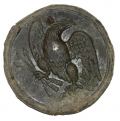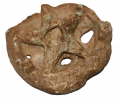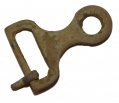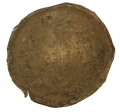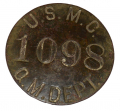site search
online catalog
Relics
Showing 281 to 300 out of 336
FIRED .577 ENFIELD BULLETS RECOVERED AT GETTYSBURG BY JOHN CULLISON
This item was recovered by local Gettysburg resident John Cullison, who excavated relics on the field from 1935-1959. Cullison sold his collection to the famed Rosensteel family of Gettysburg, who… (R17332). Learn More »
DROPPED .54 CAL. MINIE BALLS RECOVERED AT GETTYSBURG BY JOHN CULLISON
This item was recovered by local Gettysburg resident John Cullison, who excavated relics on the field from 1935-1959. Cullison sold his collection to the famed Rosensteel family of Gettysburg, who… (R17331). Learn More »
US PATTERN 1826 EAGLE BREAST PLATE, FROM G.A.R. POST 551 COLLECTION (YORK SPRINGS, PA)
This Federal shoulder belt plate is of the regulation 1826 pattern. Constructed in the die-struck and rolled brass method, the brass accoutrement’s face shows a clear eagle in the center. Face has a… (2022-1849). Learn More »
RELIC WORLD WAR ONE BRITISH SMLE WIRE CUTTER HEAD
During World War One the ubiquitous wire cutters played an important role in trench raids and assaults. Leading elements would use these cutters to penetrate the enemies wire entanglements and clear a… (490-3926). Learn More »
RELIC – BIG BROKEN BRASS SPUR FROM ORANGE, VIRGINIA
This is about half of an excavated spur…very large and heavy western-style spur. This piece consists of one are and the neck/rowel. The other arm is broken off and missing. Measures approximately… (1184-389). Learn More »
FIELD-MADE COPY OF STAR AND CRESCENT CAPE PIN
This is an excavated relic from a camp near Orange, Virginia. Using a brass star and crescent cape pin, some creative or bored soldier made this piece. Creating a mold by pressing the original cape… (1184-288). Learn More »
DUG BRASS BULLET MOLD
This is a very nice brass bullet mold. In “dug” condition, the brass has an even green patina. Measures 4” long overall. The mold is stuck partially opened. It has two cavities; casting two .31… (1184-337). Learn More »
RELIC ISAAC & CAMPBELL KNAPSACK HOOK
This is an excavated Confederate knapsack buckle from an imported knapsack manufactured by S. Isaac Campbell & Company in London. This company supplied numerous articles of war to the… (1184-304). Learn More »
RELIC STATE OF NEW YORK “SNY” BELT PLATE
This is a nice excavated SNY belt plate. Pattern 1839 belt buckle with puppy-paw hooks. Beautiful brown face with the letters “SNY” in the center. Light wear over face with smooth chocolate brown… (2022-1554). Learn More »
SKIN ONLY OF A US PATTERN 1826 EAGLE CARTRIDGE BOX BREAST PLATE DUG AT FREDERICKSBURG
The face is slightly discolored from ground action leaving a mix of dark and light patina. The darker portion is along the bottom half of the eagle. The surface of the plate has a light waviness to it… (2022-1410). Learn More »
RELIC PAIR OF CIVIL WAR ENLISTED SHOULDER SCALES
Introduced in 1851 for mounted troops, brass shoulder scales were decorative, but were also meant to be a shoulder defense against saber cuts. In 1854/55 they became regulation for all branches of… (1184-299). Learn More »
CONFEDERATE .69 CALIBER “BRITISH SEA SERVICE” RIFLED MUSKET BULLET
Collectors call this a “British Sea Service” bullet because of its reference in a very early bullet reference book. However, there is no research to support this. It is a Confederate-made bullet… (1184-365). Learn More »
CONFEDERATE .50 CALIBER “MACON” CARBINE BULLET
Known as the Macon carbine bullet for no particular reason, this bullet features a round nose, two grooves, and a solid base. Bullet has been fired but remains in excellent condition with only faint… (1184-369). Learn More »
RELIC .36 CALIBER BRASS TWO-CAVITY BULLET MOLD – RECOVERED NEAR FREDERICSBURG
This is an excavated .36 caliber two cavity bullet mold for “Navy” revolvers. The mold halves are brass with a steel sprue cutter, screw, and pins. The mold is approximately 5” in overall… (2022-1313). Learn More »
POST CIVIL WAR VIRGINIA TWO-PIECE SWORD BELT BUCKLE
This sword belt plate is very similar to some wartime and prewar Virginia plates, but we feel it probably postdates the war, though excavated in Orange, Virginia. The central disk with narrow edge… (1184-117). Learn More »
RELIC BRASS STAR & CRESCENT-SHAPED CAPE PIN & CHAIN EXCAVATED NEAR FREDERICKSBURG
Excavated brass cape pin and chain. Although not actually a “pin,” a chain connected two such pieces and was run through button holes to hold a cape closed. These are found in various shapes… (2022-1349). Learn More »
RELIC CIVIL WAR PICKET PIN – RECOVERED NEAR FREDERICKSBURG
This is an excavated Civil War iron picket pin. A regulation piece of equipment for cavalrymen. Used to stake-down a horse temporarily while on picket or grazing. Measures 11 ½” long overall.… (2022-1391). Learn More »
RELIC WW1-ERA USMC QM DEPARTMENT BADGE
This is an excavated badge from an employee at the U.S.M.C. quartermaster department. The brass badge is engraved “U.S.M.C. / 1098 / Q.M. DEPT.” and has an even “dug” green patina. There is a… (2022-1369). Learn More »
RELIC “STAR” DEVICE RECOVERED NEAR FREDERICKSBURG
This is an excavated brass star. The piece has a smooth chocolate-brown patina overall. Measures 35mm across. A small central hole on the back side is the only indication of where an attachment device… (2022-1346). Learn More »
SECTION OF M1863 MUSKET WITH BLOWN BARREL FOUND IN PENNSYLVANIA CAVE
Offered here is the rear portion of a Model 1863 rifle musket, with severe damage, that was reportedly found in a Western Pennsylvania cave by arrowhead hunters. The rifle musket looks to have been… (991-25). Learn More »
Showing 281 to 300 out of 336
Most Popular
Historical Firearms Stolen From The National Civil War Museum In Harrisburg, Pa »
Theft From Gravesite Of Gen. John Reynolds »
Selection Of Unframed Prints By Don Troiani »
Fine Condition Brass Infantry Bugle Insignia »
Large English Bowie Knife With Sheath 1870’S – 1880’S »
Imported (Clauberg) Us Model 1860 Light Cavalry Officer's Saber »
featured item
LARGE FRAMED RELIC SHOWBOARD
This relic board is very like those assembled from Gettysburg relics by John Rosensteel and displayed on the porch of the Round Top Museum, but differs in displaying the relics on horizontal rather than raw vertical boards, in having a glass frame,… (1242-06). Learn More »





